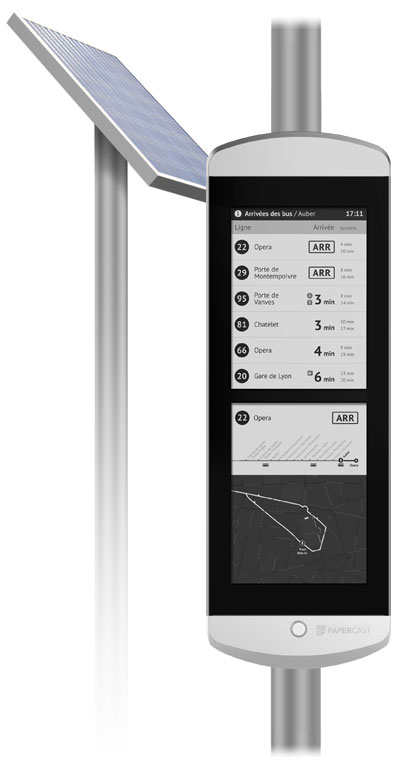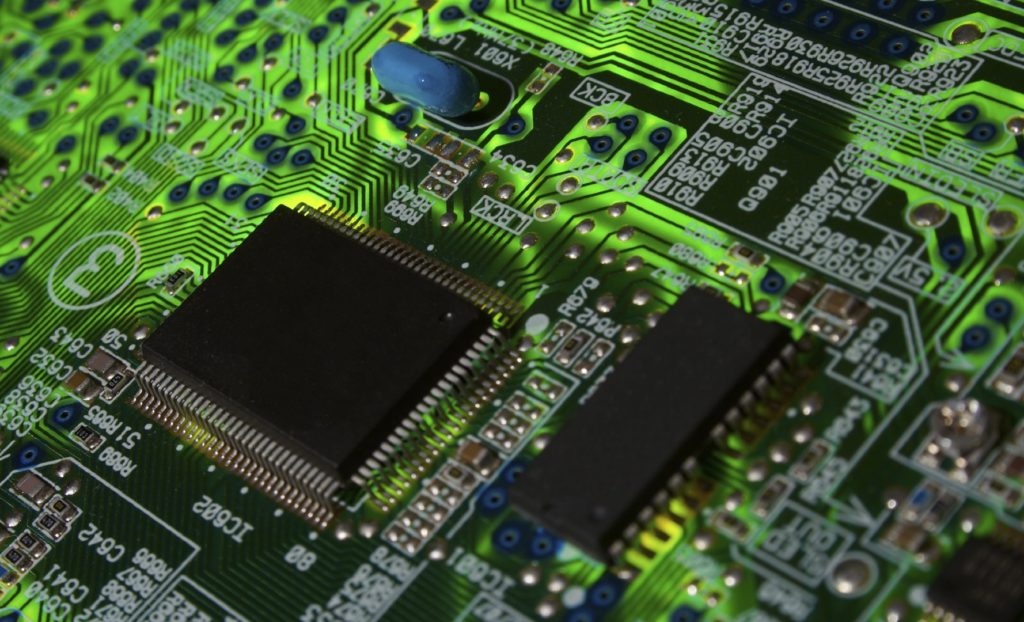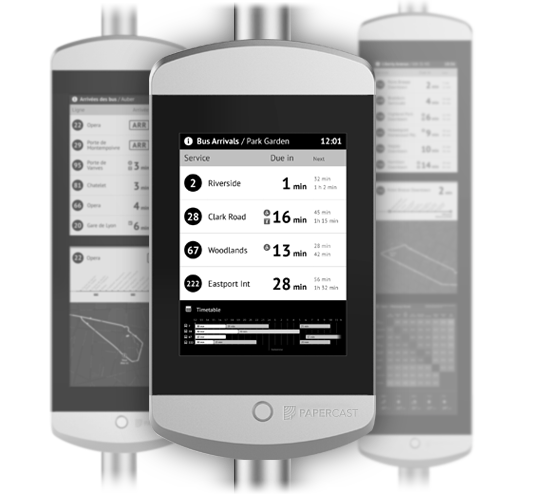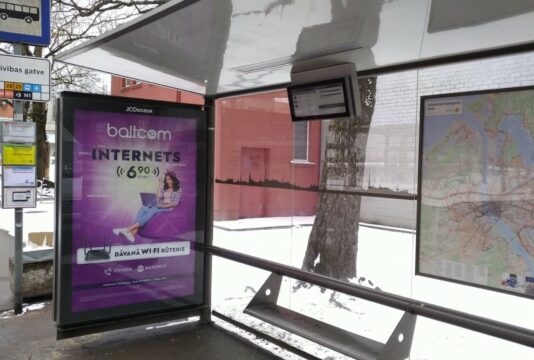If you work for a transport authority or transit service operator and customer satisfaction or passenger information falls into your remit, you will be aware of e-paper as an emerging display technology, particularly in bus mobility where bus stops are often “off the grid”.
You will also know that there is an increasing number of players with varying backgrounds, either with their roots in the technology, transport or information space. Regardless of their heritage, they all have one thing in common: they have realised the vast possibilities that e-paper offers as a digital RTPI display technology.
So, what factors should be at the front of your mind when evaluating the different options available on the market? Here are 7 things you need to look out for when selecting the right technology.
1. Validate claims of sustainable solar power operation
E-paper is one of the lowest power display technologies in the world. The benefit is that, theoretically, the display can operate indefinitely on a solar charged battery system. This is one of the characteristics that make it so well suited to outdoor applications. Whilst it is a genuine benefit, you should be aware that not all solutions are created equal.
There are many electronic and software elements that make a passenger information system operational. The nuances of how the platform is designed, developed and built can significantly affect the performance and power consumption of the display. The difference between the most superior and the average RTPI e-paper display available today is as much as 9-times less energy consumed.
Think about the impact this has on the feasibility of the display operating on solar power, or other sustainable power sources (such as micro turbine).
Be sure to get into the detail of this when exploring the options, not all solutions live up to their claims, so ask the right questions. Some of the following points will help you with this.

2. Understand how the display is controlled
What we mean by this is the e-paper display board, driver, processor or controller. It is the same thing but with different terminology, for the purposes of this article we will call it the controller. Essentially, this is the electronics that controls the display, from content rendering and image processing to data communication and power management.
Find out all you can about the controller. Has it been designed to deliver the features you need, while at the same time delivering optimum power performance? Is it future-proof, does it have enough horsepower to add new features in the future should the need arise? Has it been designed to operate multiple displays, perpetually solar powered with a 50W panel via a small integral power pack – which is the expectation of many operators we talk to?

3. Ask to see how the content processed on the display
There are several ways that the content can be processed on the screen. The first is a complete content refresh, which is standard on most platforms and comes with several downsides.
One alternative is local content rendering with partial screen refresh, this means only a few kB of data needs to be transferred versus the full image (i.e. 200kB). It should also be noted that the controller influences the speed of refresh, which can be virtually seamless (sub-second) if engineered to do so. This approach significantly improves the customer experience, virtually eliminating content flicker. It also demands a fraction of the power and data transmission, delivering considerable power performance and minimal communication costs.
Something else to mention here is built-in memory. No doubt you will invest in a resilient platform, but what if? Is there an option to show a static bus timetable should the display be ‘out of service’ for any reason? If not, what happens and what impact will this have on the passenger experience?
There is more to the display than what you can see, particularly if you require an audio interface for visually impaired customers. If this is the case you will need to ensure this is fully supported, again with optimised processing power. What about multilingual/multi-characterset – do you need this and if so, is it supported?
With so much at stake, this is something you need to get your teeth into.
4. Find out how the displays are managed
While we are on the matter of content, perhaps now is the time to think about how the content is disseminated to the display. Firstly, if a standalone unit is important, you need to know that the display has integrated resilient wireless connectivity that is optimised for low power consumption and minimal data transmission (for power and cost reasons).
Secondly, is there a management system that enables you to control the content on the displays? How do you access it and how does it work? Does it offer easy open data integration, supporting standards such as GTFS and SIRI? How much content customisation does it offer and how much control do you have? Does it offer your expected levels of data security? If there isn’t a management platform, how do you distribute content and what is involved with the integration? What about display and power monitoring and diagnostics?

There is much variation in this area so find out what’s on offer and request a full demonstration.
5. What about the actual display units and your physical environment?
There are several combinations available and you probably need to consider what’s going to integrate seamlessly with your current infrastructure. Displays sizes are typically available in 9”, 13” and 32”.
The 32” screen is large and so potentially can display more information, or provide better visibility to a larger crowd of commuters. However, it is important to consider whether your bus stop design can accommodate a large screen.
The 13” display is becoming the most popular, particularly in multiples in a stacked design. Not only does the multiple configuration offer the ability to display the same information portfolio as the larger size displays, but it is much more likely that you will be able to utilise existing bus stop infrastructure to mount them.

Do you have existing hardware that the displays will be fixed to or do you plan to incorporate the display into an infrastructure refresh?
How important is easy installation, do you want to be able to install the displays quickly and cost-effectively with no civils work? If this is the case, then you should consider a standalone unit with a mechanism designed to securely fix the display onto an existing bus flag or pole, or in a bus shelter.
In summary, this needs careful consideration on your part, it may be that one specific approach is right for you, or a combination.
6. Ensure the display delivers the contrast and readability you’d expect
There are a few things to be aware of here. The first is that E-Ink (the manufacturer of the actual e-paper panel) is constantly improving resolution and contrast. Make sure your supplier is using the latest and greatest version, this should not be assumed.
The second is the enclosure. In fact, there is more to say about this and so it is covered in in the point below. But something to note here is that the casing can affect the visibility of the display, so be sure to have the conversation because there can be a compromise.
Where anti-glare is offered as a feature (it isn’t in all cases), there are several protection methods available. One option retains high contrast with a plastic front offering minimum glare, but the compromise is that it offers lower UV/IR protection. Alternatively, you can opt for high protection with anti-glare front glass, which slightly reduces the contrast with some glare, but the higher protection rating ensures a longer lifetime of the screen.
There are other specifications available, but give some thought to what is most important to you. As with everything, materials are continually improving, but for now you can have the discussion with these facts in mind.
7. You need to know your displays are protected
So, the enclosure. Design is important, you want your new real time passenger information platform to shout forward thinking, quality and innovation for many years to come. But it needs deliver more than aesthetics.
You need your display protected in an enclosure and you should be looking for an IP65 rating against the elements, as well as against IR and UV radiation. You also need to know your device will remain within the safe temperature parameters required by E-ink screens. You need it to defy acts of vandalism, ideally with an integrated accelerometer and built-in telemetry. You need low power night time LED illumination so that the display is fully readable in the dark.
You will also need it to have a fixing mechanism that is secure, applicable to your physical infrastructure and as easy as possible to install. Or you may have specific needs that require a bespoke solution. You will need to discuss this with your potential supplier. As you will see, there is a fair bit to consider here.
In all honesty, we could go on, but these are the main points that are often overlooked. We hope this has given you something to think about and that you have found this useful?
If you have any questions or need additional support or advice in any of the areas explored in this paper, please do not hesitate to get in contact, visit www.papercast.com for further information
“Working with you to improve customer experience and overall utilisation of public transport by keeping passengers more reliably informed, by helping as many service providers as possible to transition to next generation technologies”



